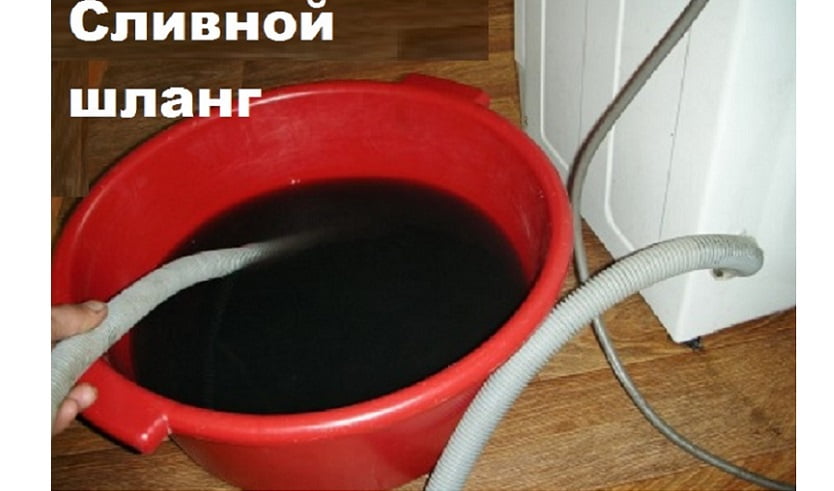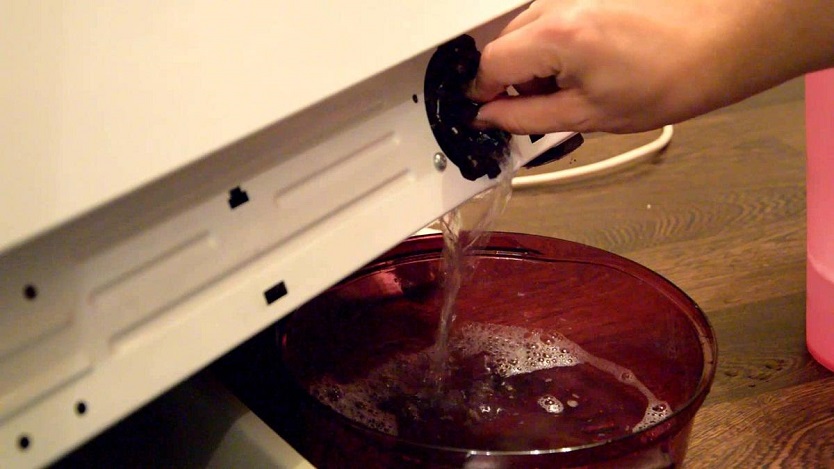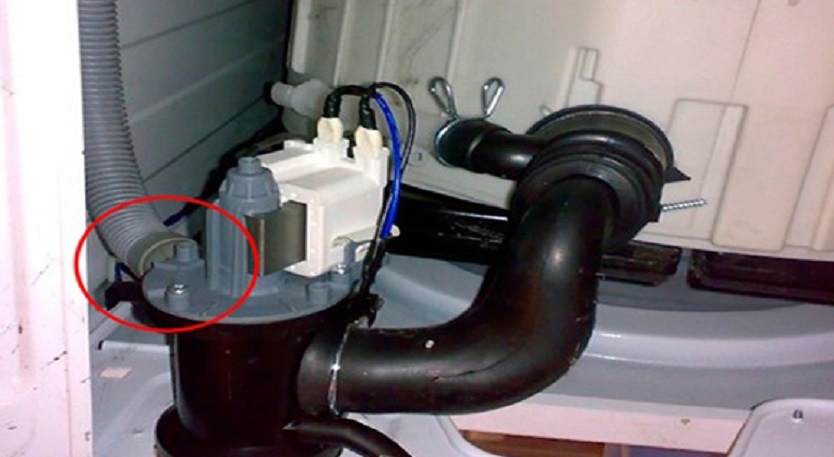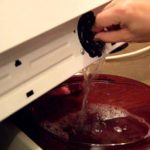If the machine breaks down during washing and the process stops, you must first turn off the machine from the electricity by unplugging the plug, and then turn off the water tap. There are 5 reliable ways to gently drain the water from the tank. You can use the dedicated emergency hose, the main drain hose, or manually drain the water through the washing tank hatch. A drain filter and a drain pipe are also suitable for removing water.
Drain hose

The easiest method to drain the water faster. Procedure:
- Turn off the power, shut off the water supply.
- Disconnect the drain hose from the rear panel.
- Pull the outlet out of the sewer pipe.
- Place the end of the hose in a container (bowl or basin) below the level of the washing tub. The capacity is required low, it is difficult to pour into a bucket using this method.
If in this way the washing machine does not drain water, which means it provides protection against leakage from the sewer hose. Inside the case, manufacturers make an additional loop with a drain hose or install a plastic elbow, so the drain hose is always above the tank level. Most often found in washing machines Bosh and Simens.
![]() See also - Samsung washing machine fault codes
See also - Samsung washing machine fault codes
Emergency hose

Designed specifically for draining water in case of breakdown. It is usually located in a special hatch at the bottom of the front panel and is closed by a small door, there is also a drain filter. In some cases, the drain mechanism is implemented in the form of a retractable plastic channel. If you cannot see the hatch on the front, then it is located under the plastic decorative panel at the very bottom. This design is found in Indesit washing machines.
Drain procedure:
- Open the hatch door, get a thin emergency hose out of the niche.
- Place a flat, wide container of suitable height under the hatch. Remove the plug from the hose, place the outlet in the container.
- Control the process so that water does not spill.
Important:
all procedures for draining water are carried out only after disconnecting the washing machine from the electrical network and water supply!
Disadvantages of the method:
- Long process of draining - up to 30 minutes;
- The emergency hose often becomes clogged with scale or other debris, so the water will not drain;
- Some models do not have an emergency hose.
Advice:
To speed up the process, tilt the machine against the wall, open the drum door, and manually scoop out some of the water. We drain the remaining water through the emergency hose.
Drain filter

It is located along with the emergency hose, which we wrote about above. Designed specifically to protect the pump from debris, small items, lint from clothes. Cleaning the drain filter the simplest and most common problem solution.
Procedure:
- Open the manhole cover at the bottom. Sometimes the hatch door can be covered with a narrow decorative panel on the bottom of the washing machine.
- Tilt the housing towards the rear panel so that a low basin can be placed under the filter to collect water. For convenience, you can lean the washer against the wall. If the slope is too large, the rear feet may start sliding over the tiles, be careful.
- Turn the drain filter clockwise by the handle. To adjust the pressure of the drained water, you do not need to twist it all the way.
- Keep the machine tilted until no more water flows into the container. At the end of draining, you will have to return the device to its normal position, and then collect the rest of the water manually.
Advice:
Prepare ahead of time by placing rags or towels to make cleaning easier after draining.
Scoop out the water manually
The most obvious and easiest way to drain the water is to manually drain it from the washing machine through the drum hatch.
Disadvantages of the method:
- You will not be able to drain all the water. As a result, the remaining water will have to be drained using a drain filter or an emergency hose.
- Long and inconvenient. Especially when compared with the first method.
- Sequencing:
- Open the door of the washing tub. A car with a front hatch will have to be tilted towards the rear wall so that water does not spill onto the floor. This is not required for vertical loading.
- After removing the laundry, scoop up the remaining liquid with a ladle or mug.
- Return the machine to its normal position. This will leave some of the water in the hose system below the tank.
Important:
Modern cars are equipped with a timer door lock and open 5-10 minutes after turning off. If the hatch is jammed, special emergency unlocking methods are used.
Drain connection

This method is used to remove water and repair a malfunction. If, when unscrewing the drain filter and cleaning it, water does not flow out, there is a blockage inside the drain pipe. You can find this corrugated thick hose yourself according to the diagram from the instructions for your washing machine. Most often located at the bottom of the back of the washing machine.
Procedure for clearing the blockage:
- Remove the back panel, secured with 4 screws.
- Place a container for water on the floor under the branch pipe or cover the floor with towels. Depending on the location of the pipe and pump, the machine will have to be tilted or even laid on its side. Therefore, act according to the circumstances, it may make sense to first drain the water in another way, and then proceed to unclog the blockage.
- Disconnect the pipe from the pump by carefully removing the collar (snail).
- If the liquid does not go away, you will have to forcefully clear the blockage. This can be done with your fingers, a pencil, a screwdriver, or with a soft wire hook.
- Did not help? There is another option, unscrew the pipe from the tank and clean it thoroughly.
- After cleaning and draining the water, return all parts of the mechanism to their place and fasten them securely. Check tightness. Connect the device to the power supply, open the tap for water supply from the water supply.
- Close the back panel.
Having done a simple repair, most likely the malfunction has been eliminated. Run a test wash without laundry and check the drain.
6 common problems why your washing machine won't drain
If the device does not drain or continues to issue an error, you need to determine the essence of the problem. Disruptions to the drain mechanism occur for 6 reasons, which we ranked by popularity, in descending order:
- Foreign objects in the drain filter.
- Clogged drain pipe.
- Pump malfunction (pump breakdown).
- Faulty pressure switch (water level sensor).
- Software failure, malfunction of the programmer in mechanical machines.
- Failure of the electronic module (brain).
Most of the problems associated with stopping the machine and the breakdown of its mechanisms can be prevented by following simple operating rules. You should carefully check the contents of the pockets of your clothes before sending them to the washing tub. Small objects such as pins, paper clips, coins can cause clogging.Sand, dust, crumbs entering the tub along with the laundry are also often problematic. It is advisable to wash fabrics that can leave a large amount of lint and fibers in special fine mesh bags.
See also:
- 10 best ATLANT washing machines according to customer reviews
- 10 best built-in washing machines
- 10 best washing machines under 15,000 rubles according to customer reviews
- 10 best washing machines under 25,000 rubles according to customer reviews
- 13 best washing machines from 40,000 to 50,000 rubles according to customer reviews

